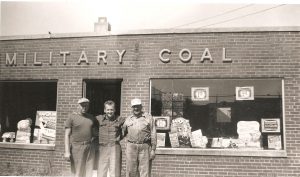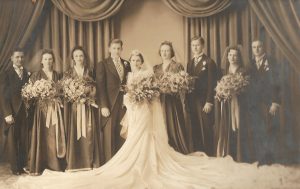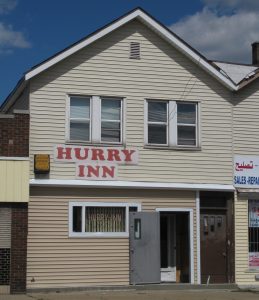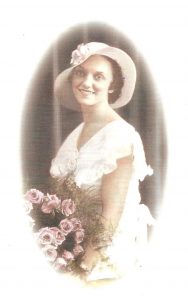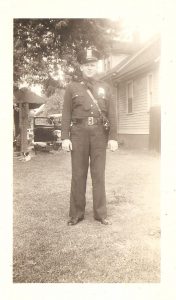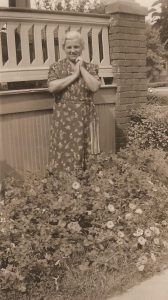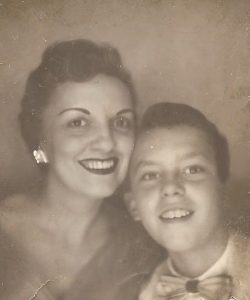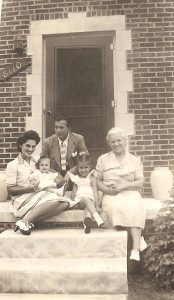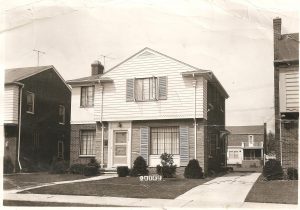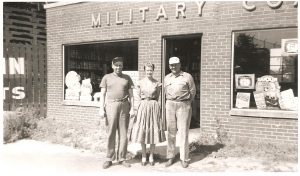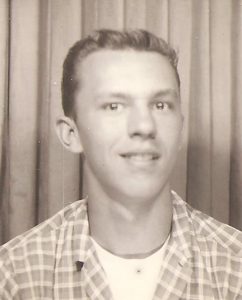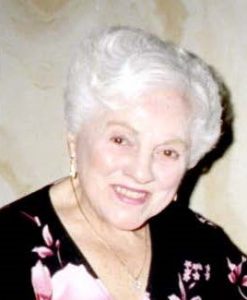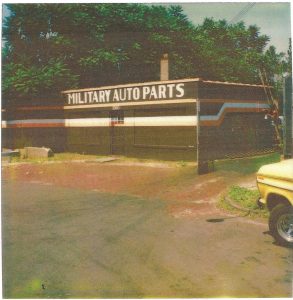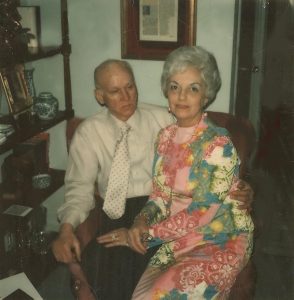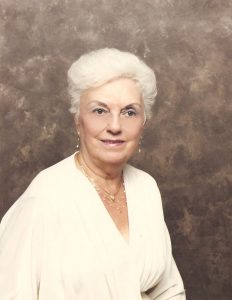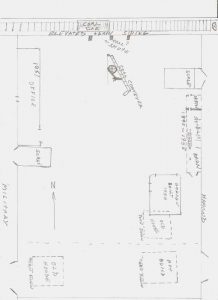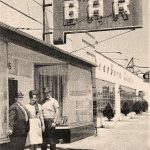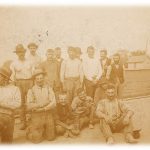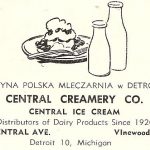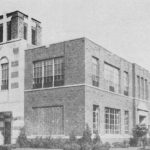History of Military Coal
Later Military Auto Parts
2360 Military Street, Detroit, MI 48209
Military Coal originated in approximately 1890 as Dumont Coal. The owner of Dumont Coal delivered coal to homes and businesses in Southwest Detroit in a horse-drawn wagon. From 1890 to 1958, there was a barn on the Hammond Street, or east end of the property, with an office on the north end of the structure. Inside the barn were stalls that were used to keep the horses that pulled the wagon for coal deliveries in the early days. The coal delivery wagon was also stored inside the barn.
Just outside the office was a large weighted scale where the coal was weighed for delivery. In the early days, the coal wagon was pulled onto the scale, where coal was added and then weighed. Later, when the horse and wagon mode of transportation was phased out, a dump truck was used. The truck was weighed as it was pulled onto the scale, and enough coal was added to the bed to meet the amount needed for delivery to homes and businesses in the surrounding neighborhoods.
There were different types of coal. There were briquettes, and there was also coal for people who had what were known as stokers. These were furnaces that had to be hand-stoked and which required a different size of coal.
The coal was delivered to the coal yard via railroad trains that arrived at the yard pulling coal cars. There was an elevated train siding on the north end of the property with coal chutes that extended from the siding, through which the coal was deposited into the yard. A coal conveyor was used to move the coal from the chutes into the truck for deliveries.
A diagram of the property, drawn by Gary Roy Martin Sr. and depicting the changes to the business and the property throughout the years, is attached to this history.
Prior to 1885, American homes were heated primarily with wood. Many homes at the time contained wood burning brick fireplaces or pot belly stoves.
In 1885, the first riveted-steel coal furnace was produced. Coal furnaces at the time transported heat by natural convection because there was neither electricity nor fans to move the air throughout homes. Warm, heated air rose through ducts from the home’s basement furnace and entered the rooms above, providing heat throughout the home. The fire in these furnaces had to be hand-stoked, meaning that the homeowner had to periodically shovel more coal into the furnace to keep the fire going. It was continuous work.
Cast iron radiators were invented around the same time. A coal-fired boiler in the home’s basement heated water that produced steam, which circulated through radiators located in every room of the house.
During the second half of the 19th century and into the first quarter of the 20th century, coal was the most abundant fuel most widely used for heating. It was also used in industrial processes. Its popularity was greatest before 1920. World War I caused major coal shortages. By the mid-1930s, fuel oil burners and other safer and more reliable heating sources became available.
In 1935, forced air furnaces using coal as a heat source were introduced. These furnaces had electric fans that distributed the heat of the furnace throughout the home via duct work.
After the Great Depression ended in approximately 1939, homeowners who were fortunate enough to have a home considered it a luxury to have a coal-burning furnace in their basement. But some were able to afford a newer, oil-burning furnace—the successor to a coal burner. Oil was seen as a cleaner burning fuel than coal. Gasoline and diesel fuel were also used as replacements for coal. Following World War II, coal for heating was becoming technologically passé. An added benefit of gas and oil-fired versions of forced air furnaces was that they eliminated the homeowner’s chore of continuously stoking the coal fire.
Stanley J. Cipkowski (July 20, 1914 – January 5, 1964), known as “Chip,” purchased Dumont Coal in 1946. Chip’s mother, Czeslawa Cipkowski (nee Moszczynska) (May 8, 1879 – April 25, 1957), was an enterprising woman. On January 23, 1901, she married Joseph Stanley Cipkowski (December 23, 1878 – November 1, 1920) in Allegheny County, Pennsylvania. They had five children: Sophie, Hattie, John, Helen, and Stanley (“Chip”).
Czeslawa and Joseph moved to Detroit in 1909. Following Joseph’s death, Czeslawa married Frank Madej (d. April 13, 1957) in Detroit on February 18, 1925. Frank’s children were Helen, Ted, and Olga Madej. Czeslawa became the owner of a biergarden on the southeast corner of Clayton and Parkinson known as the Clayton Café, which was a very popular place. Kitty-corner from the Clayton Café, on the northwest corner of Clayton and Parkinson, was Mrs. Olada’s candy store.
In approximately 1930, Stanisław (“Stanley”) (1878 – 1931) and Anna Korzeniowska Gomulka (1886 – December 18, 1965) and their children had arrived in Detroit for a second time from Latrobe, Pennsylvania. They rented a flat on Clayton Street behind the Clayton Café. Czeslawa, who was always known as Mrs. Madej to the Gomulka family, along with her children, became very close to the Gomulka family.
Mrs. Madej’s family owned a house on one corner of Clayton and another house on the other corner of the street. The Madej family was well-known throughout the neighborhood. Leontyne Gomulka (October 31, 1915 – May 1, 2008), known as Leona, Stanley and Anna’s youngest daughter, met Chip when she was 15 years old, and she knew then that he would one day be her husband. He was her one and only love.
Both Chip and Leona attended Western High School. Leona attended high school for one year and then dropped out to go to work to help raise her younger siblings. Chip went through the eleventh grade and then dropped out to go to work for Kelsey-Hayes on Fort Street. He then went to work for Chrysler as a press operator. On the weekends, he worked at the Clayton Café with his mother. He also worked at the Hurry Inn, a bar owned by his brother John (“Johnny”). Chip’s sisters, Sophie and Hattie, stayed home and took care of the house while their mother ran the bar. One of the Clayton Street flats had a vestibule with a big window seat in the front, where Sophie and Hattie loved to dance.
Chip was a great dancer also, and he and Leona loved to go dancing together every weekend at such places as the Grande Ballroom, the Graystone Ballroom, St. Stephen, Our Lady Gate of Heaven, Our Lady Queen of Apostles, and the west side Dom Polski. They also went on Boblo boat cruises, where there was dancing.
In the 1920s, both Leona and her older sister Sophia (December 10, 1913 – January 21, 2003) worked at the Ritter Cigar Box Company on Leib Street near Jefferson Avenue in Detroit. Leib Street was in the area where E. Harbortown Drive is today, east of the Rivertown-Warehouse District. Sophia and Leona earned $16 or $17 per week assembling cigar boxes for Mr. Ritter. They took the bus and had to transfer at least twice to get to work. When they got paid, they put away enough money to buy stockings and bus fare and gave the rest of their pay to their mother.
Chip and Leona, the childhood sweethearts, were married on September 11, 1937. Sophia and brother Tadeusz (“Ted”) Gomulka (October 26, 1919 – August 18, 1998) stood up in their wedding. Their reception was held at the west side Dom Polski on Junction. They lived at 6616 Barlum until the spring of 1941. Then they lived above the bar until February 1942, when they moved to their new dream home at 8110 Strathmoor Street in northwest Detroit.
The Strathmoor house was a beautiful brick bungalow that they purchased for $4,500. It had hardwood floors, wet plaster walls, and coved ceilings. Chip then purchased the coal yard on Military Street and changed the name from Dumont Coal to Military Coal.
When Chip purchased the coal yard, the phone number to the yard was TA5-5400. (The “TA” stood for TASHMOO.) Later, in the 1960s, when telephone exchange names were dropped and seven-digit phone numbers replaced them, the phone number was changed to 554-0430. No area codes were used as part of phone numbers at that time.
On the other side of the viaduct, up one block from Military Coal, at 3050 Hammond Street, was Hammond Coal. It was owned and operated by Chip’s brother, Johnny Cipkowski. Johnny also owned the Hurry Inn located at 19430 W. Warren Ave. between Minnock and Westwood Streets in Detroit’s Warrendale district. The bar is still open and operating as of 2020.
While working at Ritter Cigar Box Company, Sophia met the love of her life, a young Irishman named Roy Martin (January 21, 1912 – December 28, 1994). Roy was born on a farm in rural Oklahoma. His mother, Lula Martin, died in 1918 when Roy was only six years old. After Roy’s father remarried, Roy had a difficult and unhappy childhood, and when he was a teenager he decided to leave the farm and travel to Detroit, where his brother was working as a police officer.
Roy hopped aboard a freight train by climbing the ladder on the side of a boxcar and securing his overall straps to the rungs of the ladder. He rode that way from Oklahoma until the train stopped somewhere in the South, where Roy disembarked and found work on a farm. He stayed on the farm long enough to save enough money to travel to Detroit. The couple who owned the farm grew to love Roy, and they treated him like their own son. They did not want him to leave the farm, but he explained that he had to move on. He climbed aboard the side of another freight train and rode north to Detroit.
Roy’s brother had written to him, giving him the street name Gratiot and telling him to make his way to the Ritter Cigar Box Company upon his arrival in Detroit. Roy found his way to the Ritter Cigar Box Company on Leib Street by asking a police officer if he knew where Gratiot Street was—grossly mispronouncing the street’s name. After showing the officer his handwritten note with the street name on it, the officer was able to direct Roy to his destination.
Mr. Ritter was a very distinguished, gray haired man who always had a cigar in his hand. He lived in a stately home on Lakeview Street on Detroit’s east side, where he loved to throw lavish parties. Instantly taking a liking to Roy, he took Roy under his wing and made him his personal chauffeur.
In 1935, Roy and Sophia were married. They had a typical Polish wedding with a reception in the Dom Polski hall on Junction, at which big bowls of chicken noodle soup were served. At the time, $4 or $5 was considered a generous wedding gift. Throughout the evening, Mr. Ritter waived around a $50 bill at the reception, letting all the guests know that he was giving a substantial gift to the bride and groom.
After Roy and Sophia’s marriage, Mr. Ritter wanted them to live in his mansion, where he proposed employing Roy as the caretaker. However, the couple was not interested in the offer. They rented a lower flat on Baldwin Street on Detroit’s east side. They later moved to a small rental home at 6609 Barlum, across and down the street from Leona and Chip, who were living at 6616 Barlum. They waited several years and saved money before starting a family. Their daughter Nancy was born on July 20, 1938. By then, Mr. Ritter had built Ritter Recreation on Jefferson Avenue in Detroit. Although he wanted Roy to remain working for him as his private employee, Roy had his sights on becoming a police officer, and he left Ritter to join the Detroit Police force.
Roy and Sophia then moved with their young daughter into Anna Gomulka’s house on Clippert Street for a short time. In approximately 1942, Roy became a sergeant with the Detroit Police Department’s Sixth Precinct on McGraw. Shortly afterwards, on January 14, 1943, Roy and Sophia’s second child, Gary Roy Martin Sr., was born. Sophia and Roy lived in the first bedroom on the first floor of Anna’s home, where they kept Gary’s bassinet. They kept Nancy’s junior bed in the dining room. At the time, Sophia was working at Lincoln Motors on Livernois and Warren Avenue, a plant that manufactured airplanes. It was during World War II, when women went to work in factories, and the idea of Rosie the Riveter took hold as women across the country seized new jobs to replace men who had joined the military. Sophia walked to Lincoln Motors and assembled airplane motors and propellers while Anna cared for Nancy and Gary.
Roy and Sophia then purchased a 700-square-foot home on Coyle Street on Detroit’s west side. But a new neighborhood began to sprout up in the McNichols-Outer Drive area of Detroit, and Roy and Sophia had their sights on their dream home in that neighborhood. Sophia saw a house on Morrow Circle in Dearborn and fell in love with it. She asked the family for the blueprints, which she received. The plans would later be used to design Roy and Sophia’s dream home.
Roy worked days at the coal yard and also worked a midnight shift at the Ford Motor plant in order to achieve their dream. Later, in 1954, when Northland shopping center was opened, Sophia began working at J. L. Hudson’s in the Better Blouses section of Women’s Apparel to help fulfill their dream of a new home. She would later transfer to Housewares, where she worked in the China section. She would continue working at Hudson’s until she was 65 years old.
Working at J. L. Hudson’s was the perfect career for Sophia. She was glamorous beyond imagination and had a huge heart. She loved people and was known for striking up conversations with total strangers. She and Leona both loved to entertain, and the elegant family parties they held at their homes and at Anna Gomulka’s house made it seem as though Martha Stewart herself had planned them. They even decorated their homemade cakes with live flowers from the garden.
When Sophia and Leona walked into a room, a hush fell over the entire room. Sometimes, when they passed by, one could hear women whispering, “Eleganckie!” Sophia and Leona were regal—queens of Polonia in the truest sense. Most important, they were never ashamed of their humble roots, and they weren’t afraid to get their hands (or their knees) dirty. During the early years of Military Coal, both Leona and Sophia regularly accompanied Chip and Roy to the business and helped out in the office and with the cleaning. They alternated weeks performing the role of mother at home and working as secretary at the coal yard.
Carol (Cipkowski) Diem, born in 1941, is the eldest daughter of Chip and Leona. She remembers as a young girl going home from school one day with a terrible stomach ache. She wanted very badly to be with her mother, but it was Sophia’s turn to be on “mom duty” that week. Carol longed only for her mother as she lay ill and recovered from what turned out to be a stomach infection.
At Military Coal, Sophia and Leona kept the office building as clean as their own homes and kept the business running smoothly. Along with their husbands, Sophia and Leona built a dynasty in Southwest Detroit, but their true empire was their family.
In 1948, Roy took an early retirement from the police force and bought into Military Coal, becoming Chip’s business partner. At the time, there were two old houses and an apartment building on the property. One house and the apartment building were on Hammond Street, and the other house was on Military. The house on Hammond was a white, two-story home. It had no electricity and no plumbing. When Sophia and Leona worked at the coal yard, they had to walk to the Hammond Street house to use the restroom. Because there was no heat or plumbing in the house, they had to carry a bucket of water with them to use to flush the toilet.
At one time, the business was known as Military Coal & Supply Company. During that time, Chip and Roy sold Sapolin brand paint, as well as Formica brand laminate. Sapolin, now a defunct business, once produced house paint as well as a high quality decorative paint. Similar to Rustoleum, the company specialized in unique colors for use on metal and surfaces other than walls.
Roy and Sophia’s son Gary accompanied his dad to the coal yard nearly every weekend from the time he was about five years old. He remembers playing on the coal piles and pretending they were mountains. Later, as an adult, he would become a shareholder in the company.
Gary remembers when the Ringling Brothers and Barnum & Bailey Circus would arrive in Detroit. The coal yard was located in an area where all the railroad tracks converged, and when the circus train arrived there was a parade of animals as they disembarked from the train cars. When the train was on their siding, Gary, Chip and Roy would watch from the coal yard as the elephants were unloaded.
One of Military Coal’s clients was the Stratford Theater at 4571 W. Vernor Highway between McKinstry and Lansing Streets in Detroit. The elegant Stratford, designed by Joseph P. Jorgerst with Adam style architecture, was opened in 1916 and had a seating capacity of 1,137. It was built at a cost of $100,000. The Dix Theater Company was the proprietor of the Stratford, which had STANDING ROOM ONLY signs out nightly in its early days. A Wurlitzer pipe organ Opus 86 built for the Stratford furnished the music.
Gary Martin remembers making coal deliveries to the theater. There was a large manhole in the alley behind the theater. The manhole cover was removed and the coal was unloaded from the truck into a chute that fed into the manhole and down into the basement of the theater until it filled the entire room. Gary’s job was to shovel the coal into the room until it was full. He then had to shovel up all the ashes and cinders for removal and disposal.
Roy Martin worked hard at everything he did, and he taught his son to do the same. His motto was, “Less than perfect is unacceptable.” That motto has remained with Gary Martin Sr. to this day.
In the early 1950s, after shoveling coal all day at the coal yard, Roy would go to Anna Gomulka’s house on Clippert Street and sleep a few hours until it was time for his midnight shift at the Ford plant. After his shift at Ford ended at 8 or 9 a.m., he would return to the coal yard and shovel coal all day. That was his routine for several years.
In 1951, Sophia and Roy purchased a lot at 17313 Westmoreland Road and sold their house on Coyle Street. They moved with their daughter Nancy and son Gary into Chip and Leona’s attic on Strathmoor Street in Detroit while their new home was being built. Chip and Leona had two daughters by that time: Carol, born in 1941, and Susan, born in 1946. Chip and Roy constructed a makeshift shower over the drain in the basement of Chip and Leona’s home using a strung-up shower curtain. The men showered there after working at the coal yard.
Using the blueprints that they had received from the family on Morrow Circle in Dearborn, Roy and Sophia had the plans drawn up for a beautiful brick Colonial style home and hired their laborers, including carpenters, plumbers, and wet plastering contractors. In the homes on Westmoreland, wet plaster—not drywall—was used for the walls and ceilings. The home featured three bedrooms, coved ceilings, and a natural fireplace. Roy and Sophia lived with their family in the attic of Chip and Leona’s house for six months while their home was being constructed. Finally, their dream home was completed, and they were able to move into 17313 Westmoreland.
Also in 1951, Chip and Roy built a new office on the Military (west) end of the coal yard property. It had a bathroom on the north end near the railroad tracks, a shower, and a sink.
Working in the coal industry was hard and dangerous work. Chip worked six days a week throughout his lifetime. One day, the coal conveyor fell on him and broke his leg.
Although times were changing, everything was good in the coal business in Southwest Detroit and at Military Coal until 1958. It was then that the Michigan Consolidated Gas Company began the conversion of coal to gas. That virtually put Military Coal out of business.
In 1958, in addition to delivering coal, Chip and Roy began buying, selling, and parting out cars in order to remain viable. Eventually, they began phasing out the coal segment of the business.
Houses in the Southwest Detroit neighborhood were built with coal chutes, which soon became obsolete. They suffered the same fate as milk chutes on houses built in the 1950s. The coal chute emptied into a storage bin in the home’s basement near the furnace. From there, the homeowner shoveled the coal into the furnace. Dump trucks replaced the horse and wagon mode of delivering coal to homes. Chip and Roy had a control-levered dump truck, which was used to deliver coal to the surrounding neighborhoods. The coal was loaded onto the dump truck for delivery. Upon arrival at a home, the truck was backed into the driveway, and the load of coal was dumped next to the coal chute. Chip, Roy, or Gary then shoveled the coal into the chute.
Before the coal segment of Military Coal’s business was phased out, Val Gomulka, who was born in 1948 and who is Roy and Sophia’s nephew (Ted Gomulka’s eldest son), got to experience first-hand the coal delivery process. He recalls many trips to the coal yard as a child, and specifically recalls accompanying Roy on a coal delivery to Anna Gomulka’s house at 3663 Clippert Street in approximately 1958. “I recall the neighborhood smelling of sulfur from all of the coal furnaces. Chimneys belching smoke left a haze in the air, which I later concluded was at least part of the reason women in the neighborhood regularly swept and washed their porches. (More recently I have concluded that porch sweeping is also an ethnic trait that I have inherited.)”
Evelyn (Gomulka) DeLabbio was born in 1946. She is the daughter of Wanda (Hoina) Gomulka (d. November 14, 2002) and Thomas A. Gomulka (December 17, 1911 – November 2, 1993), Sophia and Leona’s older brother. As a child, Evelyn lived with her parents in the upper level of Anna Gomulka’s Clippert Street house. She not only remembers when Chip and Roy would deliver coal to Anna’s house, but she also remembers the ice man delivering large blocks of ice for Anna’s ice box before she had a refrigerator.
Wanda Gomulka was another female entrepreneur. She owned and operated Kay Fashions (formerly Evelyn’s Dress Shop) at 7342 Michigan Avenue at Tarnow for many years.
Carol (Cipkowski) Diem remembers riding to Toledo with her dad in the old Ford pickup truck to get a part for the truck. She also remembers the waffle man traveling throughout the neighborhood with his wagon and selling waffles sprinkled with powdered sugar.
Sometime before 1958, Chip and Roy had the vacant Hammond Street house torn down. They also built a large garage next to the site where the house had been torn down.
Around 1958, as the company was changing, Chip and Roy purchased a house on Military Street, which expanded their business space to four or five lots. They incorporated the business as Military Enterprises, Inc. Roy became President; Gary Martin Sr. became Vice President; and Chip was named Secretary & Treasurer. Gary, who had grown up in the business, was 20 or 21 years old at the time.
At that time, a man by the name of Stanley (“Stan”) Tryles (September 4, 1916 – November 1, 1982) was working at the coal yard as a coal salesman. He lost his job when coal sales were phased out.
As things were changing, the old barn on the Hammond Street end of the property had to be torn down. It was deteriorated, and it was no longer serving any useful purpose. Gary hooked a chain to the barn, hooked the other end of the chain to a coal truck, and pulled until the barn collapsed.
By the early 1960s, the original property entrance was no longer being used. The coal portion of the business had been phased out completely. It was at that time that Chip and Roy applied for a salvage auto parts license and turned the company into an automotive salvage and parts business, which became known as Military Auto Parts. What resulted was the creation of a complete automotive recycling center.
One day, Stan Tryles showed up at the coal yard and said, “I’m here to work.” It was a fortuitous turn of events, as he was able to loan Chip and Roy the capital they needed for the conversion of the business. He became a partner and ended up working at the yard until 1981.
As part of the conversion, all the coal, the conveyors, the apparatuses, and the like were recycled and cut up for scrap. For quite a few years, they kept the company tractor and used it to pull engines. Roy sent Gary to the Wolverine School of Trades on Fort Street to learn all that he could about the business.
Sadly, Chip passed away on January 5, 1964, at only 49 years of age. Roy purchased the business from his estate. Roy and Sophia became shareholders of the stock.
When Chip passed away, Leona went to work in Admitting at Mount Carmel General Hospital at 6071 West Outer Drive in Detroit. She was hired for the position in Admitting because the hospital staff was looking for someone who was a “people person.” All the doctors and staff greatly respected Leona. She continued working at Mount Carmel until her retirement in 1981, when she was given a huge party. Leona was known as a “woman of substance.”
Throughout the years, Sophia and Leona continued to go to Military Auto Parts every other week to help out with the business.
Sometime during the 1960s or 1970s, Roy had the other house and the apartment building on the south end of the property torn down. Roy and Sophia bought the property from the City and erected gates on both the Military and Hammond Street ends of the property.
In 1981, Gary, who had been working as a truck driver, lost his job. He then went to work full time at Military Auto Parts. He paid off Stan Tryles and was given one-third ownership in the company. Roy and Sophia retained two-thirds joint ownership.
Around that time, Gary and his son, Gary Roy Martin Jr. (September 14, 1966 – September 6, 2015), completely repainted the company’s main building. They painted the exterior brown with orange and white stripes that encircled the entire building.
Roy and Gary worked six days a week, from 8:00 a.m. to 5:30 p.m. Everyone knew that Military Auto Parts dealt strictly in cash. They generated business by advertising in the Yellow Pages and by running an ad in the Detroit News, requesting cars. They bought a lot of cars from Jerry Bielfield Ford (now Jorgensen Ford)—damaged cars that could not be placed on the dealer’s sales lot. Then they got connected with Tommy Szott Jeep in Taylor and also purchased wrecked cars from insurance companies. They went to insurance company auctions, bid on cars, and brought them back to the shop.
They had anywhere from 100 to 150 cars on the premises at a time. Military was a dead end street, and it provided the perfect location for their used car lot. They lined up cars with FOR SALE signs on them from one end of the street to the other.
They sold about 400 to 500 cars a year and derived income from car parts and wrecked vehicles. They also worked as mechanics, installing what they sold: engines, transmissions, and all other car parts.
At one time, Walter (“Wally”) Gomulka (January 11, 1924 – October 31, 2005), Sophia and Leona’s youngest brother, also worked at Military Auto Parts. There was an incident in which he was accidentally attacked by the company’s watch dog, a German shepherd. He was transported to Zieger Hospital, where he had his wound treated and stitched up.
On another occasion, Roy was injured quite badly. He was pouring gasoline into the gas tank of a car when the car exploded. He was rushed to Delray Hospital, where he was treated in the burn unit.
Beginning in 1981, Gary’s wife Connie (Wick) Martin also began working at the yard. She worked part-time every Monday, Wednesday, and Friday until the business was sold.
Roy passed away in 1994, and Gary continued to operate Military Auto Parts for six more years as the neighborhood deteriorated and crime in the area rose. In 2000, he received a commitment from a buyer and sold the business. Today, the business is still operating at the same location under new ownership.
Sophia passed away in 2003, leaving a void that can never be filled.
Roy and Sophia Martin live on in the home of Gary Martin Sr. and his wife Connie. The family gathers today for holidays and special events around Sophia’s dining room table, under the hanging chandelier from Westmoreland Road. When the table is pulled apart from the middle, you can see written on the table slides in Sophia’s handwriting a record of significant dates, holiday gatherings and special meals shared at the table throughout the decades—champagne bottles opened, christenings and milestone birthdays celebrated, loved ones who were no longer present. If an unkind word is uttered or if something is said that Sophia would not approve of, the chandelier bulbs flash. Similarly, when someone at the table says something that Sophia would be happy with, the chandelier lights flicker. Her beautiful spirit lives on.
The Cipkowski and Martin families were entrepreneurs who successfully operated Military Coal and Military Auto Parts at 2360 Military Street in Southwest Detroit for 54 years. As the decades passed, they were able to evolve and reinvent the business, constantly adapting to the ever-changing times. Through years of hard work, they realized their own American dreams while leaving a legacy in Southwest Detroit.
Sources:
- Evelyn R. (Gomulka) DeLabbio. Telephone conversation. (West Bloomfield, MI: January 16, 2020)
- Carol A. (Cipkowski) Diem. Telephone conversation. (West Bloomfield, MI: June 1, 2020); hand-written notes (Rochester Hills, MI: June 2020)
- Val D. Gomulka. Email message. (College Station, TX: February 8, 2020)
- Gary R. Martin Sr. and Connie Martin. Personal interview and discussions. (Southgate, MI: January 31, 2020 and February 14, 2020)
- https://www.achrnews.com/articles/87039-the-1930s-passing-the-torch-from-coal-to-oil-heat
- https://www.oldhouseguy.com/heating-old-octopus-furnace/
- www.waterwinterwonderland.com
- www.cinematreasures.com
Photos and Images:
- Military Coal. Left to right: Roy Martin (co-owner), Casimer Gomulka, and Stanley (“Chip”) Cipkowski (co-owner) (September 1952)
- Wedding Portrait of Stanley (“Chip”) Cipkowski and Leona (Gomulka) Cipkowski (September 11, 1937). Sophia Gomulka, third from left; Ted Gomulka, third from right. (Photo: Mazur Studio, Michigan Ave. near Central, Detroit)
- Hurry Inn, 19430 W. Warren Ave., Warrendale district, Detroit, owned by Johnny Cipkowski In the 1940s. (Photo: Laurie A. Gomulka, September 5, 2010)
- Sophia Gomulka (ca. 1931)
- Sergeant Roy Martin, Detroit Police Department, McGraw Station (August 1942)
- Anna Gomulka Redzej, 3663 Clippert St., Detroit (ca. 1942)
- Sophia Martin and son Gary Roy Martin (ca. 1950)
- On the porch of 8110 Strathmoor, Detroit. Left to right: Leona Cipkowski, Ted Gomulka, Anna Gomulka, Carol Cipkowski, and Nancy Martin (ca. 1942)
- Roy and Sophia Martin’s dream home at 17313 Westmoreland Road, Detroit (1951)
- Military Coal. Left to right: Roy Martin (co-owner), Virginia (“Dinny”) (nee Lee) Gomulka, and Stanley (“Chip”) Cipkowski (co-owner) (September 1952)
- Gary Roy Martin, Sr. (ca. 1960)
- Leona Cipkowski (October 2005)
- Military Auto Parts main building exterior (ca. 1981)
- Roy and Sophia Martin in their Westmoreland home (ca. 1976)
- Sophia Martin (ca. 2000)
- Hand-drawn diagram of Military Coal/Military Auto Parts Property (February 2020: Gary R. Martin Sr.)
